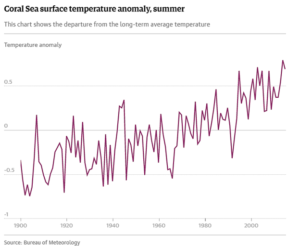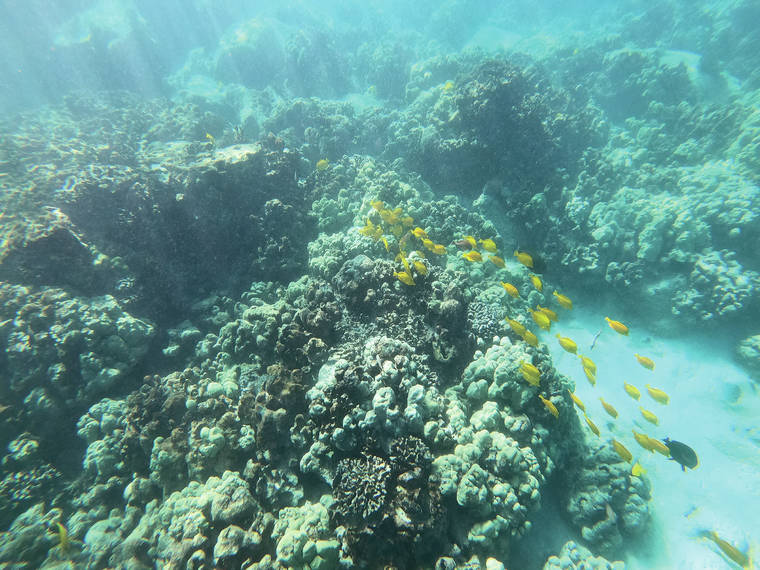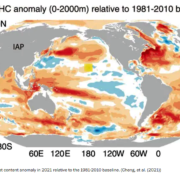Great Barrier Reef on verge of another mass bleaching, is Hawaii next?
Temperatures over the Great Barrier Reef in December (summer for Australia) were the highest on record with “alarming” levels of heat that have put this one-of kind ocean jewel on the verge of another mass bleaching of corals. Recent global climate changes represent a new normal of extremes in global air and water temperatures and weather.
According to Kyle Van Houtan, with the Monterey Bay Aquarium’s oceanography research team… “Extreme climate change is here, it’s in the ocean, and the ocean underpins all life on Earth.” More than 90% of the heat trapped by greenhouse gases is absorbed by the ocean, which plays a critical role in maintaining a stable climate.
Record breaking high ocean temperatures hit the Great Barrier Reef marine system in what has been considered an unprecedented reef bleaching event of 2015-16. And as these southern hemisphere high ocean temperatures migrated north with seasonal changes, the summer of 2015 was offer no relief for the northern latitudes and the Hawaiian island chain, which experienced a summer of massive coral die-off with devastating and last results to the state’s marine coral reef systems.
Scientists analyzed sea surface temperatures over the last 150 years, which have risen because of global heating linked to rising levels of carbon emissions, primarily associated with fossil fuels. The Monterey Bay research findings determined that extreme temperatures were occurring just 2% of the time a century ago and recently have risen to more than 50% of the time across global oceans since 2014.
 What does this mean for Hawaii this coming summer and the state’s marine coral reef systems?
What does this mean for Hawaii this coming summer and the state’s marine coral reef systems?
If the global marine heating patterns of 2015-16 repeat, Hawaii can likely expect this summer’s warming to produce further coral die-off, possibly repeating the severe temperature impacts to the corals which survived the 2015 bleaching event. The surviving coral species in Hawaii’s waters represented so-called temperature-tolerant marine corals, which also have their own limits and tolerance to high ocean temperatures. 
Recent science and history have taught us that temperature extremes have an outsized impact on ecosystems, including documented changes to near shore marine environments in both latitudes, and from the deep ocean environments to coral reefs, kelp, most fish species, and most other marine life.
The scientists have also examined ocean temperature records from 1920 through 2019, the most recent year available. They found that by 2014, more than 50% of the monthly records across the entire ocean had surpassed the once-in-50–years extreme heat benchmark. The researchers called the year when the percentage passed 50%, and did not fall back below it in subsequent years, the “point of no return”.
By 2019, the proportion of the global ocean suffering extreme heat was 57%. “We expect this to keep on going up,” said Van Houtan. But the extreme heat was particularly severe in some parts of the ocean, with the South Atlantic having passed the point of no return in 1998. “That was 24 years ago – that is astounding,” he said.
“You should care about turtles, seabirds and whales, but even if you don’t, the two most lucrative fisheries in the US, lobster and scallops, are in those exact spots,” said Van Houtan, while 14 fisheries in Alaska have recently been declared federal disasters.
The Climate Connection
The heat content of the top 2,000 meters of the ocean set a new record in 2021, the sixth in a row. Prof John Abraham at the University of St Thomas in Minnesota, one of the team behind the assessment, said ocean heat content was the most relevant to global climate, while surface temperatures were most relevant to weather patterns, as well as many ecosystems.
“Oceans are critical to understanding climate change. They cover about 70% of the planet’s surface and absorb more than 90% of global warming heat,” Abraham said. “The new study is helpful because the researchers look at the surface temperatures. It finds there has been a big increase in extreme heat at the ocean’s surface and that the extremes are increasing over time.”
All coral will suffer severe bleaching when global heating hits 1.5C, study finds. Almost no corals on the planet will escape severe bleaching once global heating reaches 1.5C.
Adding to this correlational data, researchers have examined exactly how much more likely the warm conditions on the Great Barrier Reef were as a result of carbon emissions.
Imagine a world without human-induced global heating – a world without humans and their carbon emissions, the conditions on the Great Barrier Reef that caused the recent past and current bleaching events would have been virtually impossible,” said Dr. Andrew King, University of Melbourne.




Leave a Reply
Join the Community discussion now - your email address will not be published, remains secure and confidential. Mahalo.